In an increasingly connected business environment, your applications must communicate seamlessly to avoid data silos and manual-entry errors. This is where api integration platforms become essential, acting as the central hub that connects your diverse software stack-from your CRM and ERP to marketing automation and project management tools. These platforms automate workflows, synchronize data in real time, and unlock new operational efficiencies, saving your team valuable time and resources.
This guide provides a detailed, comprehensive review of the leading API integration platforms available today. We move beyond marketing copy to offer an honest assessment of each tool's strengths and limitations. You will find in-depth analysis of key features, practical use case scenarios for small businesses and specific industries, and transparent pricing information. To understand the practical benefits, consider how a robust integration solution can boost collaboration and efficiency between sales and development teams, such as through seamless HubSpot Jira Integration.
Our goal is to equip you with the insights needed to select the right platform for your specific business requirements. Each review includes screenshots and direct links, helping you compare your options and find the perfect fit to streamline your operations and scale your business effectively.
1. MuleSoft Anypoint Platform
MuleSoft's Anypoint Platform is a heavyweight contender among api integration platforms, designed for enterprise-level challenges. It provides a unified, highly scalable solution for the entire API lifecycle, from initial design and development to management and security. This makes it ideal for large organizations managing complex, interconnected systems across on-premise and cloud environments.
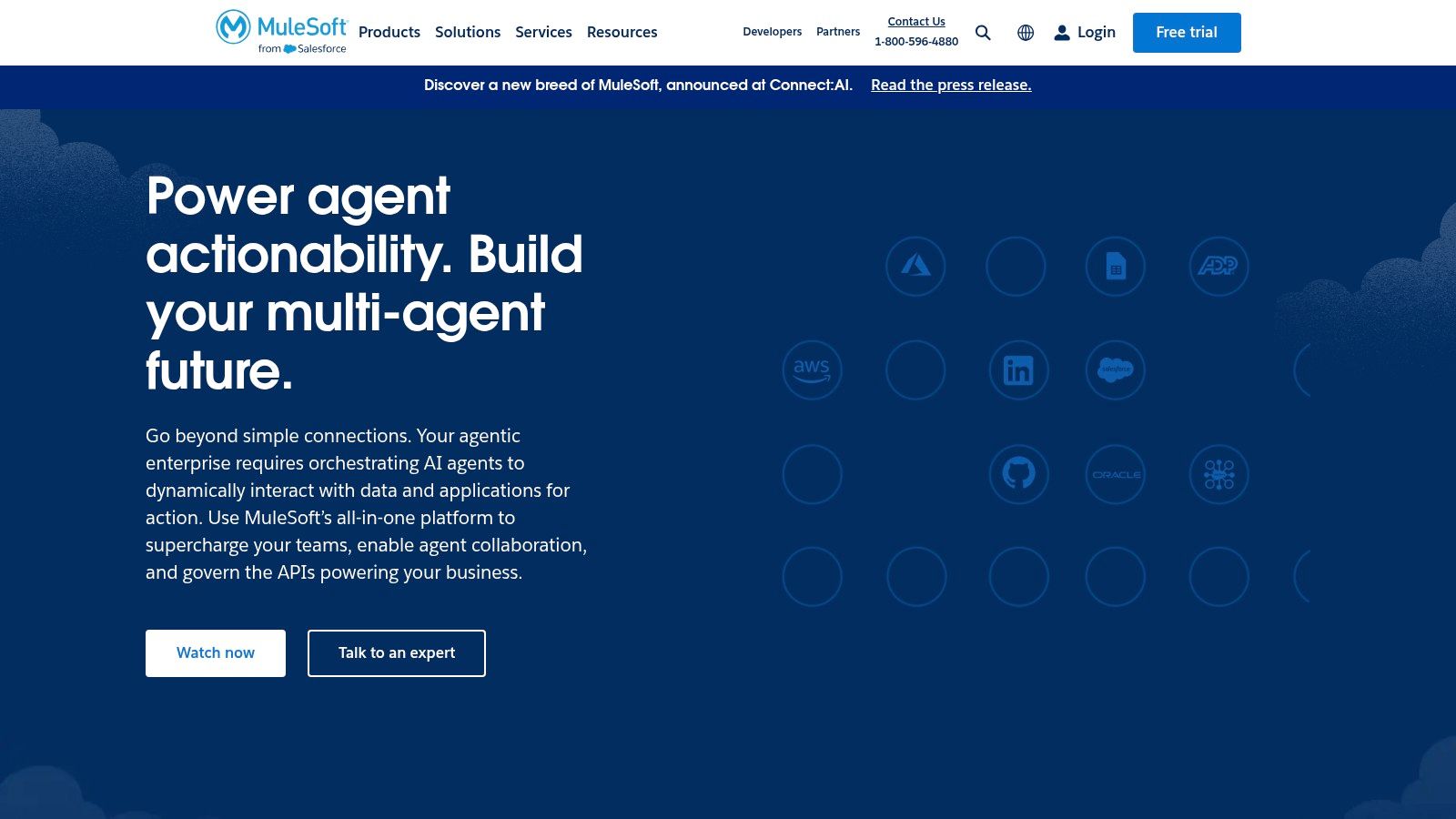
The platform stands out with its API-led connectivity approach, promoting the creation of reusable assets. This strategy helps businesses build an "application network" where components are discoverable and can be easily composed to accelerate project delivery. For instance, a retail company can create a reusable "customer data API" that can then be plugged into e-commerce, marketing, and customer service applications without redundant development work.
Platform Analysis
- Best For: Large enterprises with complex integration needs and significant IT resources.
- Key Feature: Its visual development environment (Anypoint Studio) and vast library of pre-built connectors significantly speed up development for those familiar with the system.
- Pricing: Custom-quoted and generally positioned at a premium price point, reflecting its enterprise focus.
- Limitation: The platform has a steep learning curve and requires specialized developer skills, making it less suitable for small businesses or teams without dedicated integration specialists.
Visit MuleSoft Anypoint Platform
2. Boomi AtomSphere
Boomi's AtomSphere is a cloud-native, user-friendly player among api integration platforms, designed to accelerate business outcomes by connecting applications, data, and people. It champions a low-code approach, empowering both IT professionals and business analysts to build integrations quickly. This makes it an excellent choice for organizations aiming to democratize integration and reduce dependency on specialized developers for every connection.
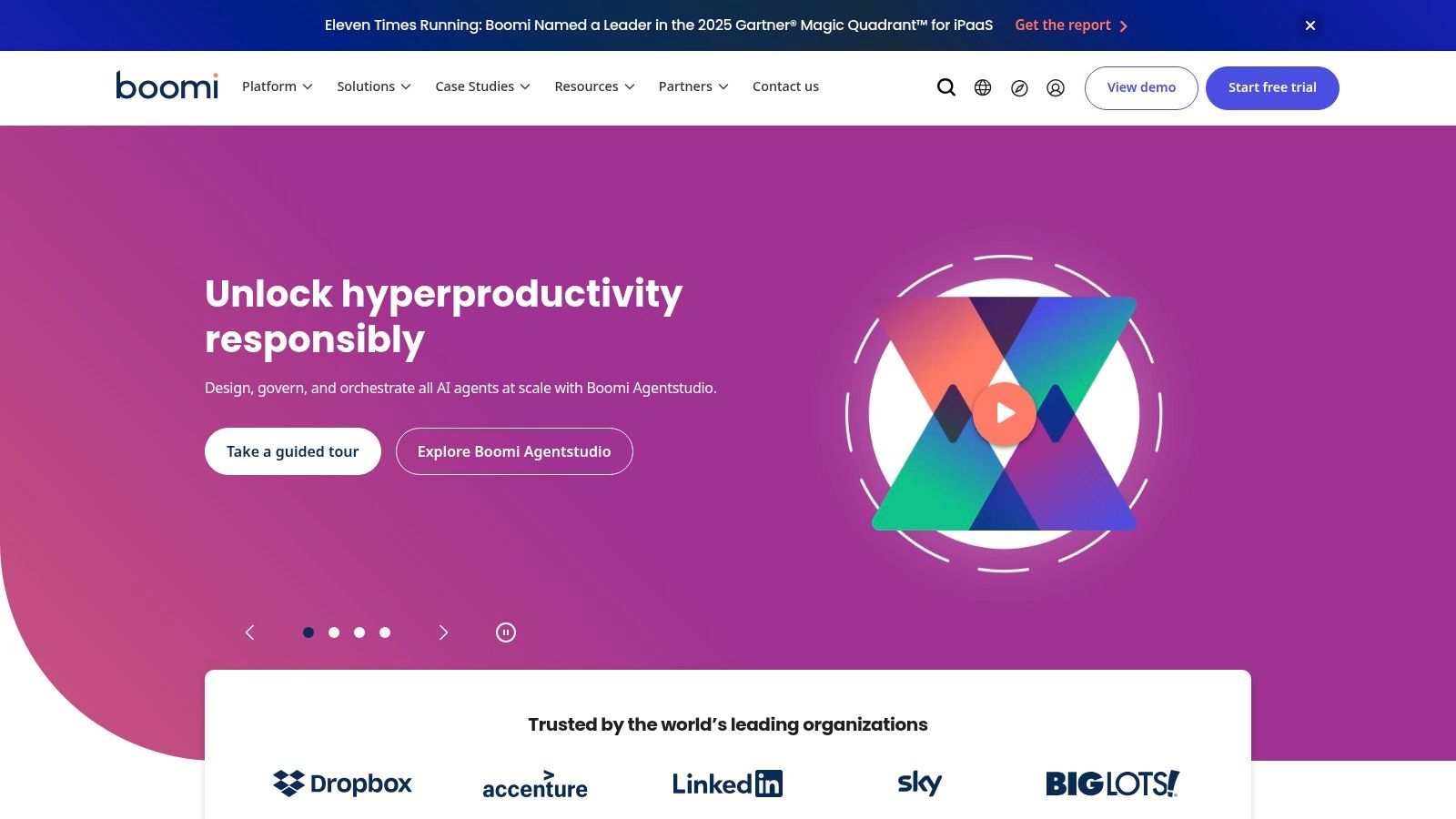
The platform's strength lies in its unified environment that handles everything from data mapping to API management and workflow automation. Its drag-and-drop interface, combined with a vast library of pre-built connectors, simplifies complex processes. For example, a mid-sized e-commerce company could use Boomi to seamlessly sync inventory levels between its Shopify store, an on-premise warehouse management system, and its NetSuite ERP, all without writing extensive custom code.
Platform Analysis
- Best For: Small to mid-sized businesses (SMBs) and enterprise departments seeking rapid integration with minimal coding.
- Key Feature: Its visual, drag-and-drop interface significantly lowers the technical barrier to entry, enabling faster deployment by non-specialist users.
- Pricing: Offers several subscription tiers based on the number of connections and features, with pricing available through a custom quote.
- Limitation: While powerful, its reliance on a cloud-based architecture means offline development and management capabilities are limited, which can be a constraint for some enterprise security models.
3. IBM API Connect
IBM API Connect is an integrated management solution built for the complete API lifecycle, from creation to socialization. It stands out among api integration platforms for its heavy emphasis on security and governance, making it a trusted choice for enterprises in highly regulated sectors like finance and healthcare. The platform provides a robust framework to create, manage, secure, and analyze APIs across multi-cloud and on-premise environments.
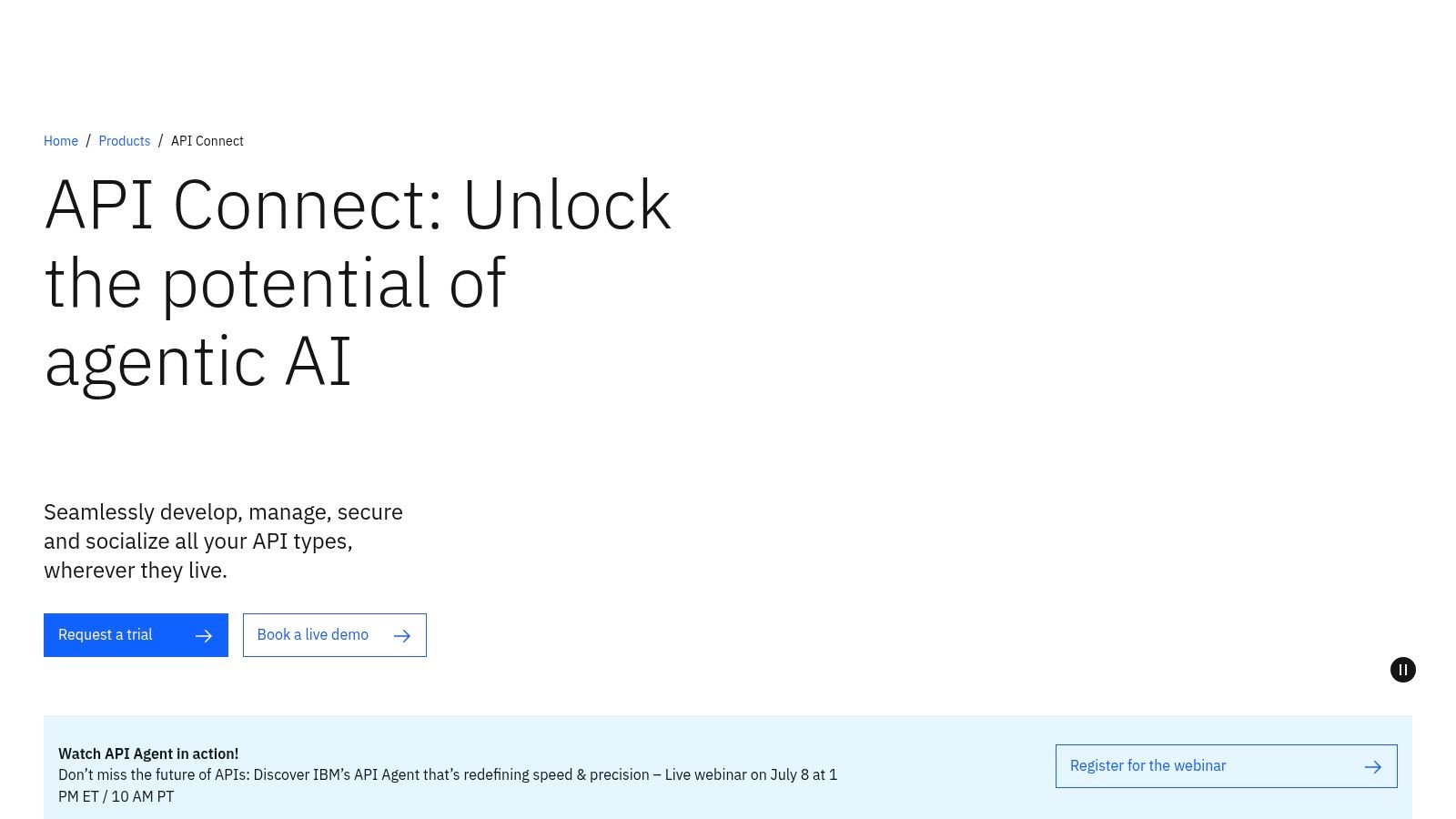
The platform’s strength lies in its comprehensive toolset that supports developers and administrators alike. It includes an automated, model-driven tool for creating APIs, a customizable developer portal for community engagement, and powerful analytics to monitor performance. For example, a bank can use API Connect to securely expose its transaction services to third-party fintech apps, while using the built-in analytics to track API consumption and ensure compliance with financial regulations.
Platform Analysis
- Best For: Enterprises in regulated industries (finance, healthcare, government) requiring stringent security and compliance.
- Key Feature: Its built-in security policies and gateway enforcement offer advanced threat protection and access control right out of the box.
- Pricing: Custom pricing based on usage and deployment model; typically caters to enterprise budgets.
- Limitation: The setup and configuration process can be complex, and its extensive feature set may be overwhelming for smaller businesses without dedicated IT security and operations teams.
4. Apigee (Google Cloud)
As part of Google Cloud's portfolio, Apigee is a powerful API management solution that excels in security, analytics, and scalability. It's one of the leading api integration platforms for businesses that need to manage the full lifecycle of their APIs, from design and security to deployment and analysis. Apigee empowers organizations to treat their APIs as products, providing tools for monetization, developer engagement, and detailed traffic management.
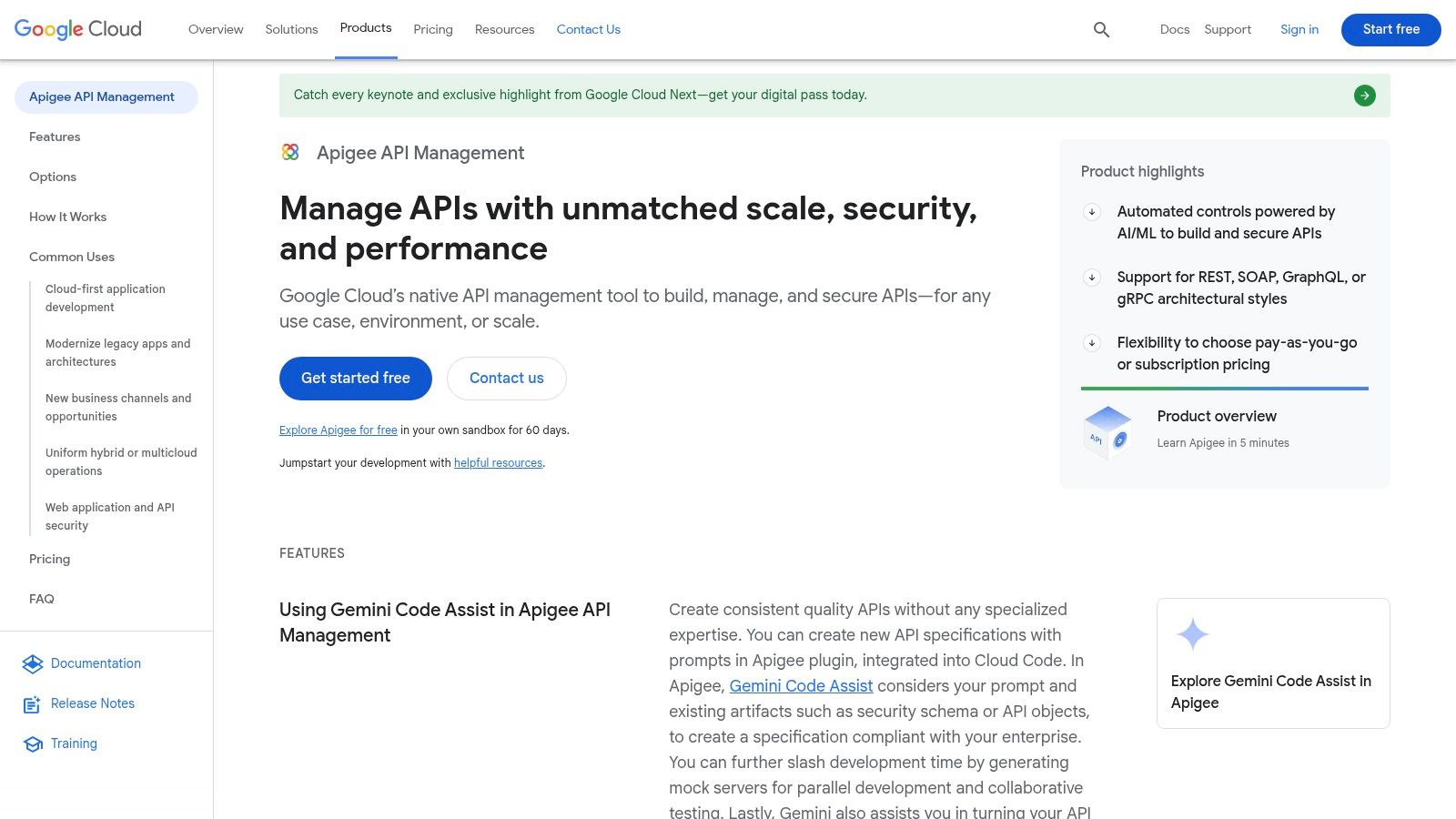
The platform’s strength lies in its ability to abstract backend complexity, offering a unified facade for various services. For instance, a financial institution can use Apigee to expose legacy banking services as modern, secure REST APIs. This allows them to build a developer ecosystem for new fintech apps while maintaining robust security and compliance controls over sensitive data. For a deeper understanding, you can explore some real-world API integration examples.
Platform Analysis
- Best For: Enterprises and high-growth companies that need advanced security, analytics, and API monetization capabilities.
- Key Feature: Its comprehensive security suite, including threat detection and OAuth/SAML support, provides enterprise-grade protection for critical APIs.
- Pricing: Offers tiered pricing, including a free evaluation tier, with paid plans based on usage (API calls). Costs can be significant at scale.
- Limitation: The platform can be complex and costly for smaller businesses or simple projects, and its version control features are considered less robust than some competitors.
5. Zapier
Zapier democratizes automation, positioning itself as one of the most accessible api integration platforms on the market. It empowers non-technical users to connect over 5,000 different web applications and automate repetitive tasks without writing a single line of code. Its "if this, then that" logic allows for the creation of workflows, called "Zaps," that move information between apps automatically.
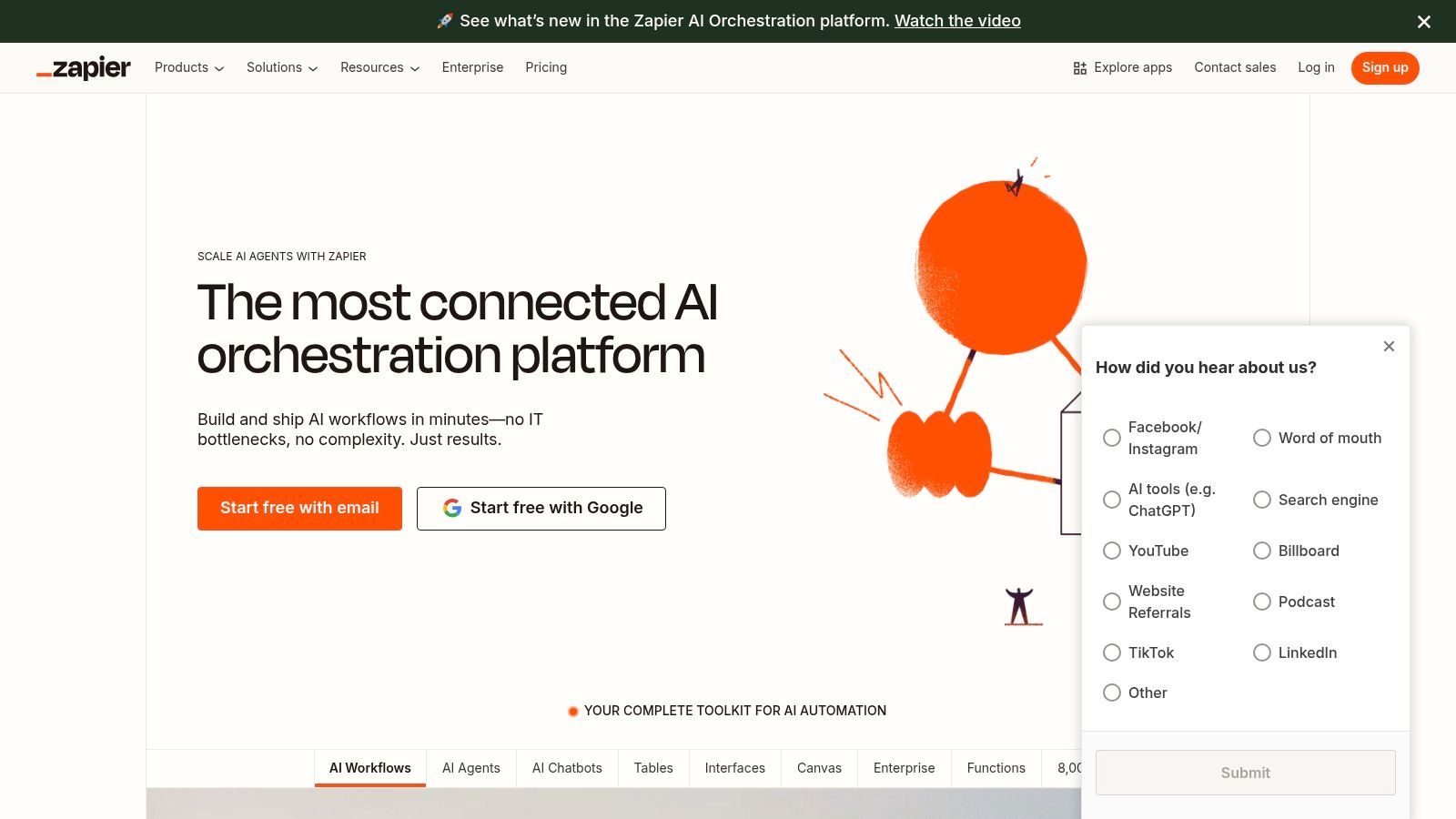
The platform's strength lies in its simplicity and vast app ecosystem. A small business, for example, can instantly create a Zap that saves new email attachments from Gmail to a specific Dropbox folder and then sends a notification in Slack. This type of straightforward, point-to-point automation is where Zapier excels, making it an invaluable tool for improving operational efficiency in marketing, sales, and administrative tasks. Local businesses can leverage these automations as part of a broader strategy; find out how Zapier can streamline digital marketing for local businesses.
Platform Analysis
- Best For: Small to medium-sized businesses, solopreneurs, and teams without dedicated IT staff.
- Key Feature: Its incredibly intuitive, user-friendly interface combined with thousands of pre-built app connectors and workflow templates.
- Pricing: Offers a free tier for basic, single-step Zaps, with paid plans starting at an affordable monthly rate based on the number of tasks and features.
- Limitation: While powerful for simple workflows, it can become expensive and less efficient for highly complex, multi-layered enterprise integrations that require robust error handling and data transformation.
6. Workato
Workato positions itself as a leader in the enterprise automation space, offering a powerful, low-code platform that democratizes integration. It enables both business and IT users to build complex workflows that connect applications and automate business processes. This makes it a standout choice among api integration platforms for organizations aiming to empower individual departments to solve their own integration challenges without heavy reliance on central IT.
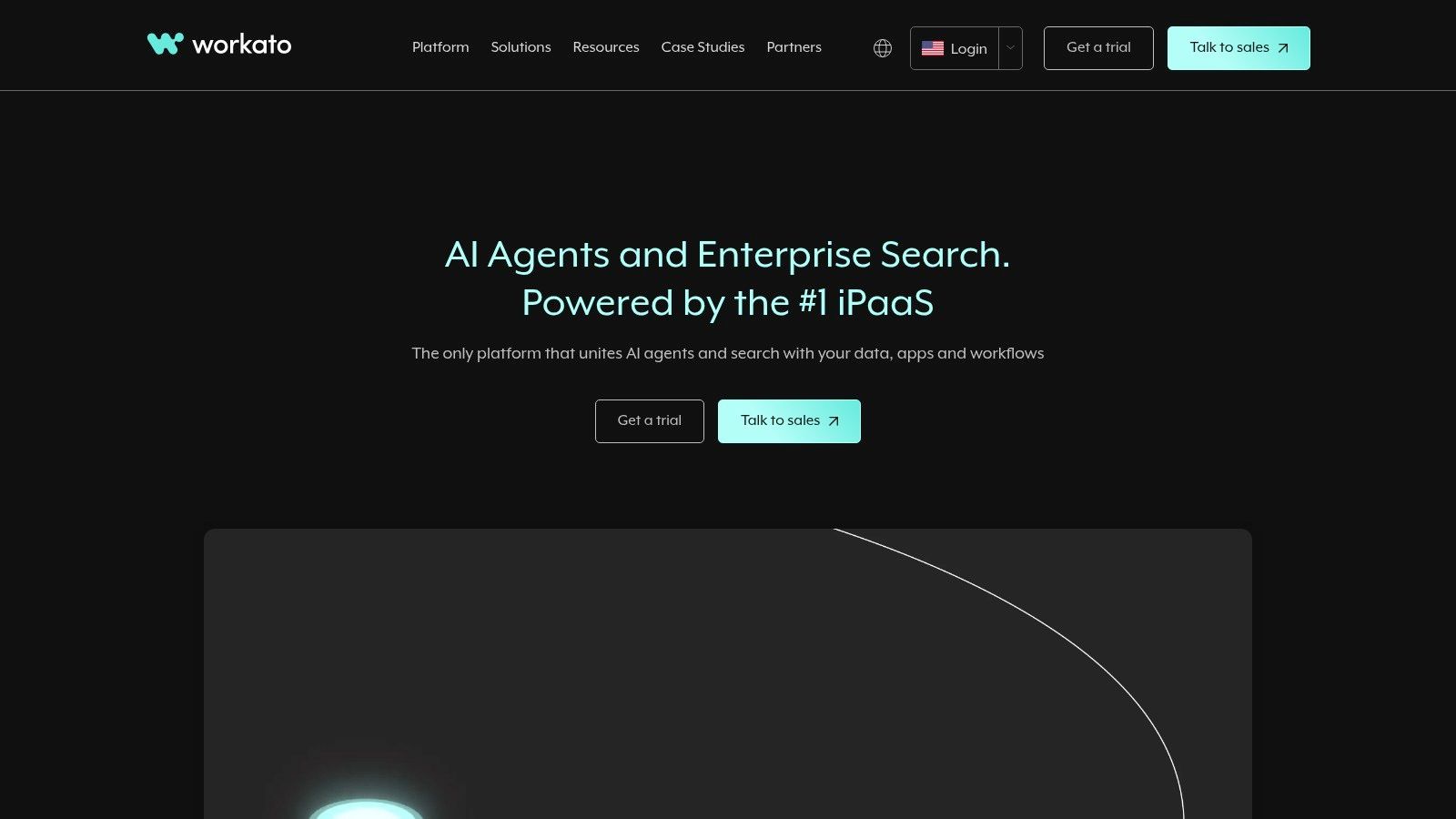
The platform is built around "recipes," which are automated workflows triggered by specific events. A user can, for example, create a recipe that automatically syncs new leads from Salesforce to a Slack channel and adds them to a Mailchimp campaign. This recipe-based approach, combined with a vast library of pre-built connectors, makes it exceptionally fast to get started with common business use cases across HR, finance, and marketing.
Platform Analysis
- Best For: Enterprises and fast-growing businesses that need to enable both technical and non-technical teams to build powerful automations.
- Key Feature: Its intelligent automation capabilities, which use AI and machine learning to help users build more effective recipes and identify automation opportunities.
- Pricing: Custom-quoted based on the number of recipes and connectors needed. It is generally considered a premium-priced solution.
- Limitation: While powerful, the platform can have a steeper learning curve when building highly complex, multi-step workflows, and its pricing can be prohibitive for smaller businesses.
7. Jitterbit Harmony
Jitterbit Harmony positions itself as a powerful, low-code api integration platform designed for speed and ease of use. It empowers businesses to quickly connect SaaS, on-premise, and cloud applications, making it a strong choice for mid-market companies that need to automate processes without a massive development team. The platform is engineered to accelerate digital transformation by simplifying the creation of new APIs and integrations.
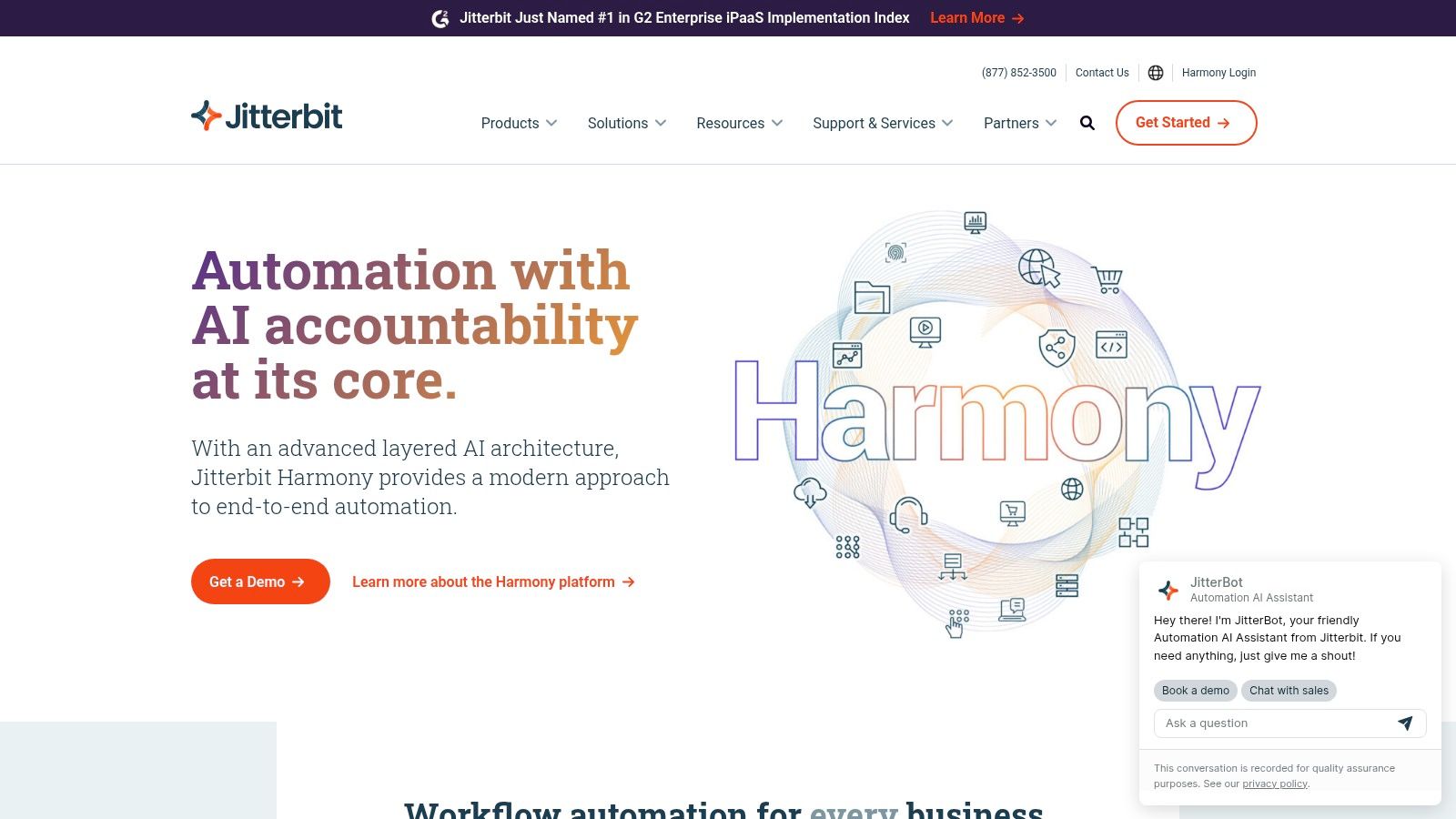
The platform's strength lies in its user-friendly visual workflow designer, which allows users to map out complex processes with minimal coding. For example, a company could use Jitterbit to create a seamless "quote-to-cash" process by connecting Salesforce (CRM) to NetSuite (ERP). This integration could automate order creation, invoice generation, and revenue recognition in real-time, drastically reducing manual data entry and errors.
Platform Analysis
- Best For: Mid-sized businesses and enterprise departments needing to deploy integrations quickly with a low-code approach.
- Key Feature: Its "Citizen Integrator" approach, supported by a vast library of pre-built recipes and templates that solve common integration patterns, enabling less technical users to build and manage connections.
- Pricing: Custom-quoted based on the number of connections and features required. It can be a significant investment, particularly for smaller businesses.
- Limitation: While excellent for rapid deployment, it may lack the deep, granular control and advanced customization features found in more developer-centric platforms, which can be a constraint for highly complex or unique integration scenarios.
8. SnapLogic Intelligent Integration Platform
SnapLogic's Intelligent Integration Platform is a powerful, self-service iPaaS that excels at connecting applications, data, and devices through a clean visual interface. As one of the more intuitive api integration platforms, it empowers both technical developers and business users to build and manage data pipelines without extensive coding. This dual-audience approach makes it a flexible choice for organizations looking to democratize integration across different departments.
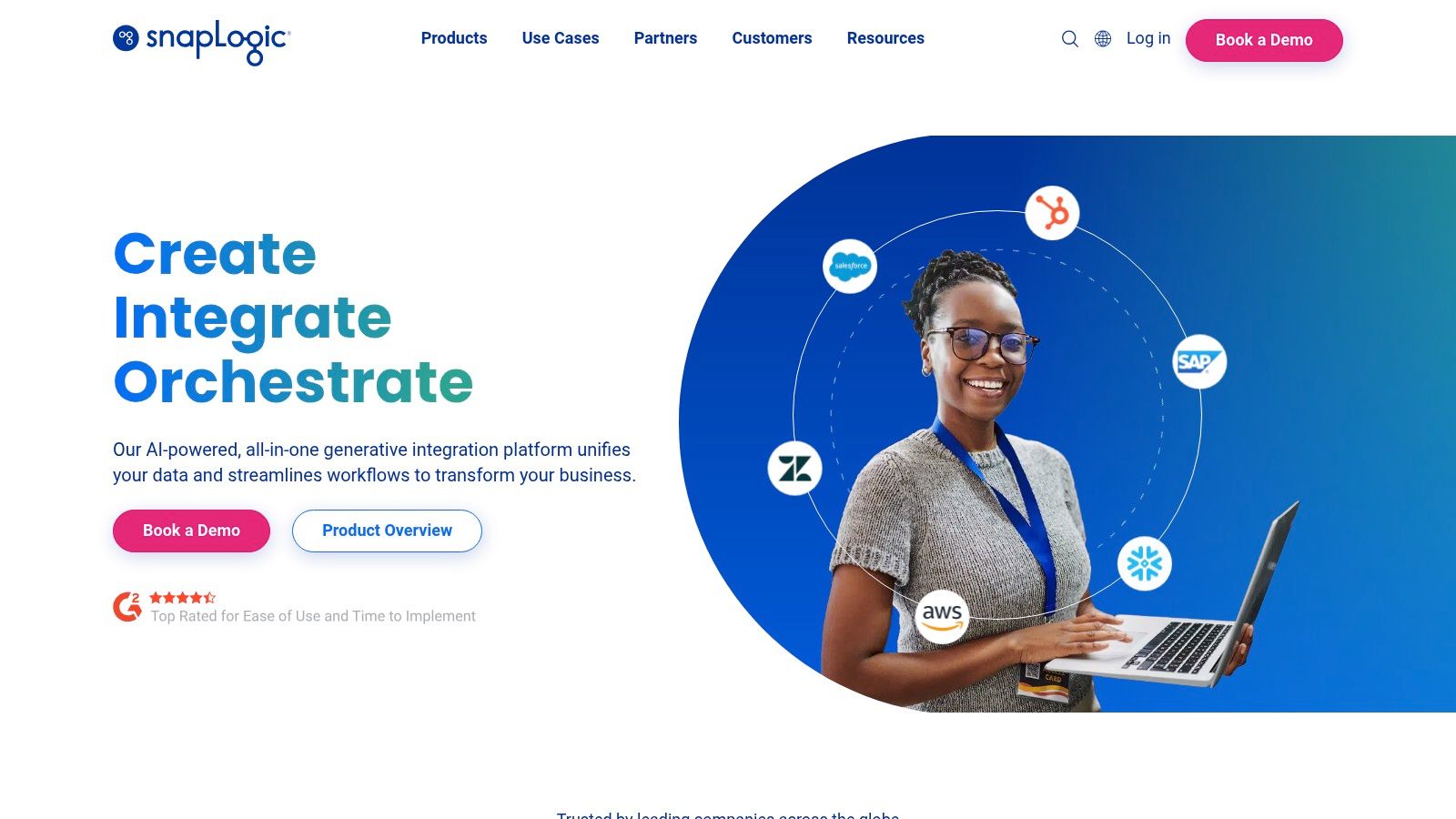
The platform stands out with its AI-powered assistant, Iris, which provides recommendations to accelerate pipeline development. For instance, if you're connecting Salesforce to an ERP system, Iris can suggest the next logical step or transformation, reducing manual effort. This AI guidance, combined with its strong support for hybrid and multi-cloud deployments, makes SnapLogic a forward-thinking solution for modern data ecosystems.
Platform Analysis
- Best For: Enterprises and mid-sized businesses needing a scalable platform that supports both citizen integrators and expert developers.
- Key Feature: Its AI-powered integration assistant (Iris) and a massive library of pre-built connectors called "Snaps" significantly reduce development time.
- Pricing: Custom pricing based on usage and features. It is generally considered a premium-priced solution compared to entry-level tools.
- Limitation: The initial setup and configuration can be complex for newcomers, and the cost may be prohibitive for small businesses or startups with limited budgets.
Visit SnapLogic Intelligent Integration Platform
9. Tray.io
Tray.io offers a flexible, low-code automation platform that empowers both technical and non-technical users to build sophisticated integrations. As one of the more modern api integration platforms, it focuses on combining a user-friendly visual workflow builder with the power to handle complex, enterprise-grade business logic. This balance makes it a strong choice for businesses that want to automate processes beyond simple point-to-point connections.

The platform shines in its ability to manage custom logic, conditional branching, and real-time data processing within its visual interface. For example, a marketing team could use Tray.io to create a workflow that syncs new leads from a webinar platform to a CRM, enriches the lead data with a tool like Clearbit, and then triggers a personalized email sequence, all without writing a single line of code. This adaptability makes it suitable for scaling from simple task automation to mission-critical business processes.
Platform Analysis
- Best For: Marketing, sales, and support teams in fast-growing companies that need to create highly customized, multi-step automations.
- Key Feature: The visual workflow builder is exceptionally powerful, offering universal connectors and logic helpers that enable complex, bespoke integrations.
- Pricing: Custom-quoted based on usage, with plans typically starting at a higher price point that reflects its advanced capabilities.
- Limitation: The pricing structure can be a barrier for small businesses or startups with limited budgets, and it lacks robust offline functionality.
10. TIBCO Cloud Integration
TIBCO Cloud Integration is a robust and flexible solution among api integration platforms, designed to connect applications, data sources, and devices across complex hybrid and multi-cloud environments. Its strength lies in offering a versatile suite of tools that cater to both business analysts with its low-code visual designer and professional developers who require more granular control. This adaptability makes it a powerful choice for organizations aiming to streamline processes and foster innovation.
The platform excels in managing the full API lifecycle, from creation and security to analytics and monetization. A key differentiator is its powerful event-processing capabilities, allowing businesses to act on real-time data streams. For example, a logistics company can use TIBCO to integrate IoT sensor data from its fleet with its inventory system, enabling real-time tracking and automated reordering triggers for a more responsive supply chain.
Platform Analysis
- Best For: Enterprises needing a versatile platform that supports diverse integration patterns, including real-time data processing and hybrid deployments.
- Key Feature: Its "develop-anywhere" approach allows users to build integrations on-premises or in the cloud and deploy them wherever needed, offering exceptional flexibility.
- Pricing: TIBCO follows a custom-quoted, subscription-based model. It is generally considered a premium-priced solution, reflecting its enterprise-grade capabilities.
- Limitation: The platform can have a steeper learning curve, particularly for users new to integration concepts, and its cost may be prohibitive for smaller businesses.
Visit TIBCO Cloud Integration
11. Informatica Intelligent Cloud Services
Informatica Intelligent Cloud Services (IICS) positions itself as a comprehensive, AI-powered api integration platform that excels in enterprise-grade data management. It enables businesses to connect applications and manage data across hybrid and multi-cloud environments, moving beyond simple point-to-point connections. The platform is designed to handle complex data integration, quality, and governance challenges at scale.
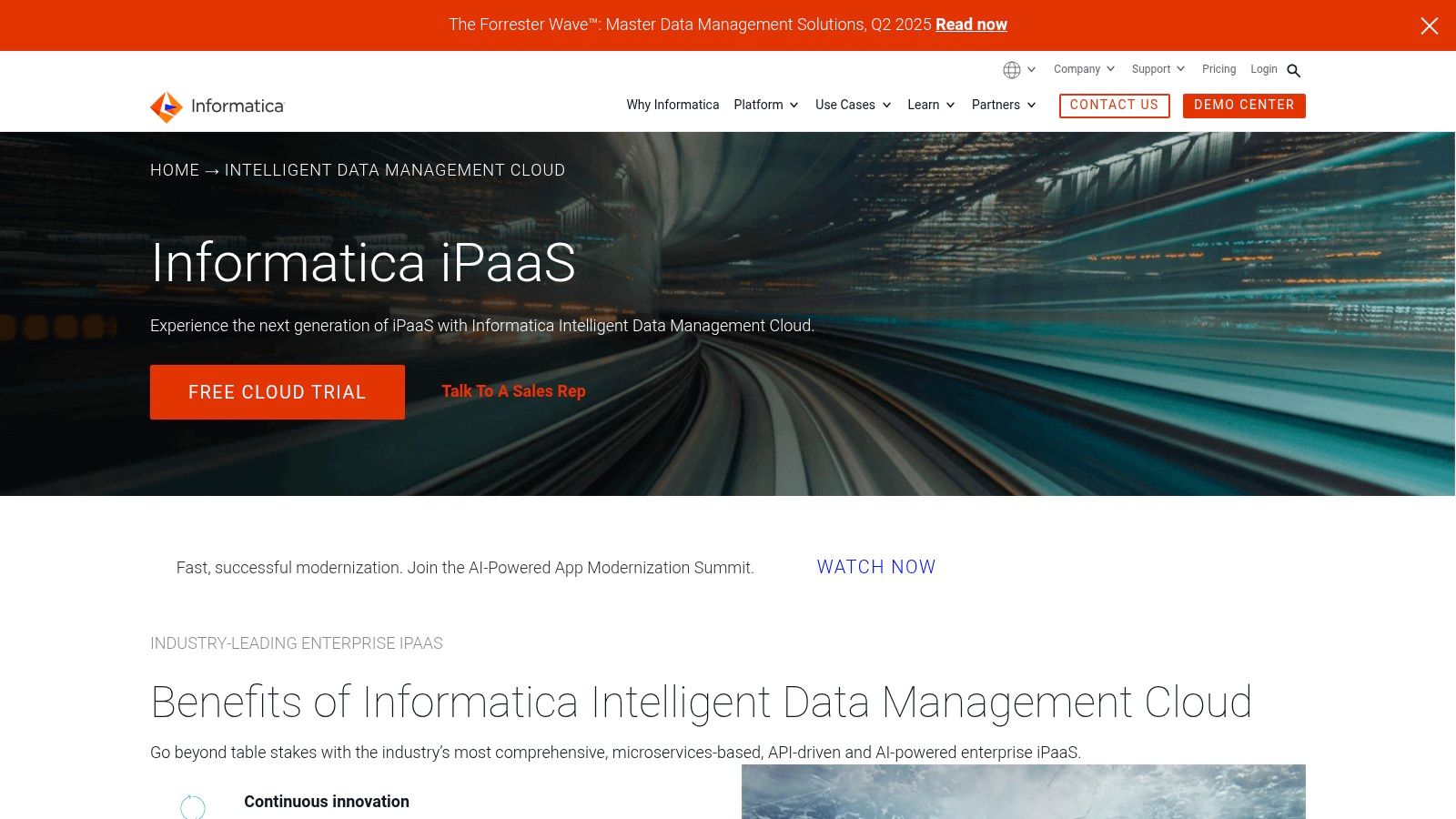
What sets IICS apart is its deep focus on the entire data lifecycle. While many platforms focus solely on API connectivity, Informatica provides robust tools for ensuring data quality, mastering data, and enforcing governance policies within the integration flows. For example, a financial institution can use IICS not only to integrate customer data from various systems but also to cleanse, validate, and govern that data in real-time to meet strict compliance standards. This makes it a strategic choice for data-centric organizations where integration and data integrity are equally critical, much like how a proper website security checklist is crucial for data protection online.
Platform Analysis
- Best For: Large enterprises and data-driven organizations requiring robust data integration, quality, and governance.
- Key Feature: Its visual drag-and-drop designer combined with strong data quality and governance tools offers a unified solution for complex data challenges.
- Pricing: Based on consumption and custom-quoted, reflecting its enterprise-grade capabilities and typically higher cost.
- Limitation: The platform can be complex to set up and may have a steeper learning curve for teams not already familiar with Informatica's ecosystem.
Visit Informatica Intelligent Cloud Services
12. WSO2 API Manager
WSO2 API Manager is a comprehensive, open-source solution that distinguishes itself among api integration platforms by offering full lifecycle API management. It empowers developers and enterprises to design, publish, secure, and analyze APIs with a high degree of control and flexibility. This platform is particularly suited for organizations that prioritize customization and want to avoid vendor lock-in while building a robust API ecosystem.
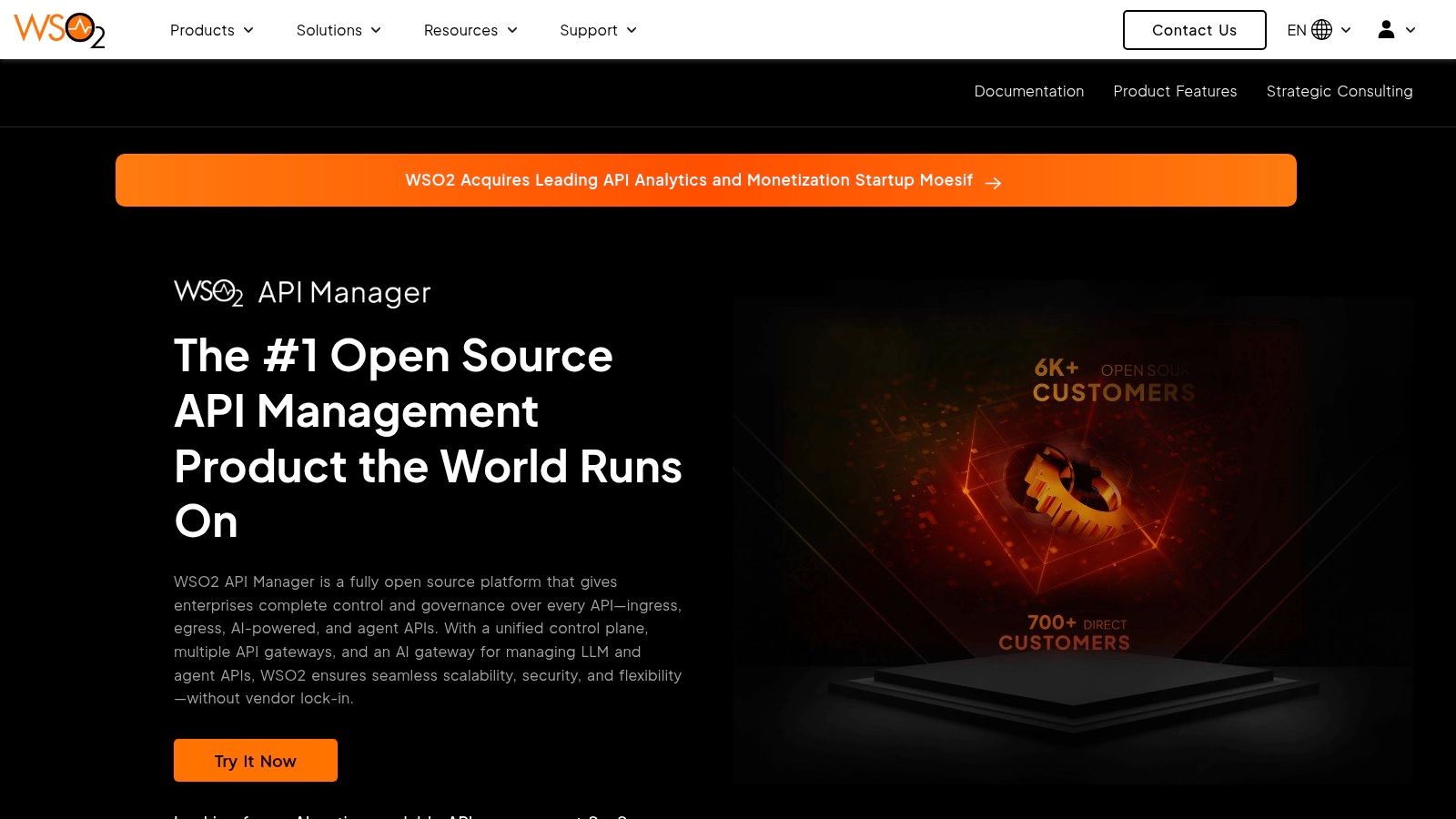
The platform's strength lies in its extensive feature set, including a developer portal for API discovery, robust security protocols like OAuth2, and detailed analytics. For example, a financial services company can use WSO2 to securely expose legacy banking data via modern REST APIs, enforce strict access policies, and monitor usage patterns to inform future development, all within a self-hosted, scalable environment.
Platform Analysis
- Best For: Enterprises and tech-savvy teams needing a powerful, customizable, and cost-effective open-source API management solution.
- Key Feature: Its open-source nature allows for deep customization and integration, giving businesses complete control over their API infrastructure and deployment.
- Pricing: The core product is free and open-source. WSO2 offers paid enterprise support, cloud hosting (WSO2 API Cloud), and consulting services for mission-critical deployments.
- Limitation: The platform demands significant technical expertise for initial setup, configuration, and ongoing maintenance, making it less ideal for teams without dedicated IT or DevOps resources.
Visit WSO2 API Manager
API Integration Platforms Feature Comparison
| Platform | Core Features/Capabilities | User Experience & Quality ★★★★☆ | Value & Pricing 💰 | Target Audience 👥 | Unique Selling Points 🏆✨ |
|---|---|---|---|---|---|
| MuleSoft Anypoint Platform | Centralized API mgmt, Microservices, Security | Robust but steep learning curve | 💰💰💰 High | Large enterprises | Extensive connectors, Scalability 🏆 |
| Boomi AtomSphere | Low-code drag-drop, API mgmt, Data governance | User-friendly, good for non-developers | 💰💰 Moderate | Growing businesses | Easy for non-tech users, secure |
| IBM API Connect | API lifecycle, Security, Analytics | Enterprise-grade, complex setup | 💰💰💰 Higher cost | Regulated industries, enterprises | Strong compliance, analytics 🏆 |
| Apigee (Google Cloud) | API lifecycle, Security, Traffic mgmt | Scalable, enterprise-ready | 💰💰💰 High | Large enterprises | Monetization, Google Cloud integration |
| Zapier | No-code automation, Multi-step workflows | Very easy, drag-drop | 💰 Affordable | Small & medium businesses | Wide app integrations, easy setup ✨ |
| Workato | Visual workflows, Complex logic, Real-time sync | Powerful but steeper learning | 💰💰💰 Premium pricing | Enterprises & tech-savvy users | Scalability, strong community 🏆 |
| Jitterbit Harmony | Low-code, API mgmt, Real-time sync | User-friendly, quick deployments | 💰💰 Higher cost | SMEs to large businesses | Flexible deployment options ✨ |
| SnapLogic Intelligent IP | Visual design, AI assistance, Multi-cloud | Intuitive but complex initial setup | 💰💰💰 High | Enterprises | AI-powered integrations 🏆 |
| Tray.io | Low-code workflows, Complex logic, Real-time | User-friendly, customizable | 💰💰💰 Premium pricing | Growing businesses | High customization, scalable |
| TIBCO Cloud Integration | Pre-built connectors, Hybrid cloud, API mgmt | Flexible, enterprise-grade, steeper learning | 💰💰💰 Higher cost | Enterprises | Hybrid support, broad integration |
| Informatica Cloud Services | Data integration, Quality, Governance | Enterprise-grade, complex | 💰💰💰 Premium pricing | Enterprises | Strong data governance 🏆 |
| WSO2 API Manager | Open-source API lifecycle, Security, Analytics | Powerful but requires expertise | 💰 Free/Open-source | Technical teams, enterprises | Open-source, customizable ✨ |
Final Thoughts
Navigating the landscape of API integration platforms can feel overwhelming, but the journey from isolated data silos to a cohesive, automated business ecosystem is a transformative one. We've explored a dozen powerful solutions, from enterprise-grade powerhouses like MuleSoft and Boomi to the nimble, user-friendly automation of Zapier and Tray.io. Each platform offers a unique blend of power, scalability, and ease of use, designed to solve different sets of business challenges.
The key takeaway is that the "best" platform is entirely dependent on your specific context. A small real estate agency needing to sync its CRM with an MLS feed has vastly different requirements than a large e-commerce startup managing a complex web of inventory, payment, and shipping APIs. Your choice hinges on a careful evaluation of your current technical capabilities, budget constraints, and future growth ambitions.
How to Choose the Right Platform for Your Business
To distill this complex decision into a clear action plan, focus on these critical factors before committing to a platform:
- Scalability: Consider not just your current needs but where your business will be in three to five years. Will the platform grow with you? Look at pricing tiers and the ability to handle increasing API call volumes and data loads.
- User Experience: Who will be building and managing these integrations? A platform like Zapier is ideal for non-technical business owners, while Apigee or IBM API Connect demand specialized developer expertise. A mismatched user experience leads to low adoption and wasted investment.
- Pre-built Connectors: The value of these platforms often lies in their libraries of pre-built connectors. Before you decide, audit your existing software stack (CRM, ERP, marketing tools, etc.) and verify that your top contenders have reliable, well-maintained connectors for your most critical applications.
- Total Cost of Ownership (TCO): Look beyond the monthly subscription fee. Factor in potential implementation costs, the need for specialized staff or consultants, and any charges for exceeding API call limits or data usage. Sometimes a higher-priced platform can have a lower TCO if it reduces your need for expensive developer resources.
Preparing for Implementation and Beyond
Successfully implementing one of these API integration platforms is more than a technical project; it's a strategic business initiative. It requires clear planning, stakeholder buy-in, and a forward-looking perspective. As you integrate these tools, you are fundamentally reshaping how your business operates, making it more agile and responsive. Understanding broader shifts, such as emerging IT support trends for 2025, can help frame the long-term value of building a robust and interconnected digital infrastructure today.
Ultimately, the goal is to unlock the full potential of your data, automate tedious manual processes, and create seamless experiences for both your employees and your customers. The right platform will serve as the central nervous system for your digital operations, empowering you to innovate faster and make smarter, data-driven decisions. Embrace this opportunity to build a more connected and efficient future for your business.
Feeling overwhelmed by the technical side of API integrations? Swish Web Designs specializes in creating bespoke web applications and seamless API integrations for small businesses, from custom online ordering systems to complex data synchronization. Let us handle the complexity so you can focus on running your business. Learn more about our custom development services.


